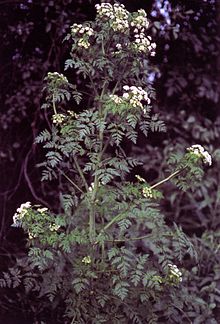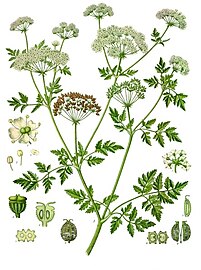Conium maculatum
| Conium maculatum | |
|---|---|

| |
| Conium maculatum in California | |
| Scientific classification | |
| Kingdom: | Plantae |
| Clade: | Tracheophytes |
| Clade: | Angiosperms |
| Clade: | Eudicots |
| Clade: | Asterids |
| Order: | Apiales |
| Family: | Apiaceae |
| Genus: | Conium |
| Species: | C. maculatum
|
| Binomial name | |
| Conium maculatum L., 1753
| |
| Synonyms[1] | |
|
List
| |
Conium maculatum, colloquially known as hemlock, poison hemlock or wild hemlock, is a highly poisonous
All parts of the plant are
Description
Conium maculatum is a herbaceous
A biennial plant, hemlock produces leaves at its base the first year but no flowers. In its second year it produces white flowers in umbrella-shaped clusters.[5]
-
19th-century illustration
-
Vertically growing specimen
-
Specimen in Chino, California
-
Flowers
-
Seed heads in late summer
Similar species
Hemlock can be confused with the wild carrot plant (Daucus carota, sometimes called Queen Anne's lace). Wild carrot has a hairy stem without purple markings, grows less than 1 m (3+1⁄2 ft) tall, and does not have clustered flowers.[6] One can distinguish the two from each other by hemlock's smooth texture, vivid mid-green colour, and typical height of large clumps being least 1.5 m (5 ft), twice the maximum of wild carrot. Wild carrots have hairy stems that lack the purple blotches.[7][8]
The species can also be confused with harmless cow parsley (Anthriscus sylvestris, also sometimes called Queen Anne's lace).[citation needed]
The plant should not be visually confused with the North American-native tsuga, a coniferous tree sometimes called the hemlock, hemlock fir, or hemlock spruce, from a slight similarity in the leaf smell. The ambiguous shorthand of 'hemlock' for this tree is more common in the US dialect than the plant it is actually named after.[citation needed] Similarly, the plant should not be confused with Cicuta (commonly known as water hemlock).[citation needed]
Taxonomy
The genus name "Conium" refers to koneios, the Greek word for 'spin' or 'whirl', alluding to the dizzying effects of the plant's poison after ingestion. In the vernacular, "hemlock" most commonly refers to the species C. maculatum. Conium comes from the Ancient Greek κώνειον – kṓneion: "hemlock". This may be related to konas (meaning to whirl), in reference to vertigo, one of the symptoms of ingesting the plant.[9]
C. maculatum, also known as poison hemlock, was the first species within the genus to be described. It was identified by Carl Linnaeus in his 1753 publication, Species Plantarum. Maculatum means 'spotted', in reference to the purple blotches characteristic of the stalks of the species.[10]
Names
Distribution and habitat
The hemlock plant is native to
It exists in some woodland (and elsewhere) in most British Isles counties;[13] in Ulster these are particularly County Down, County Antrim and County Londonderry.[14]
It has become naturalised in Asia, North America, Australia and New Zealand.
Ecology
The plant is often found in poorly drained soil, particularly near streams, ditches, and other watery surfaces. It also appears on roadsides, edges of cultivated fields, and waste areas.[15] Conium maculatum grows in quite damp soil,[20] but also on drier rough grassland, roadsides and disturbed ground. It is used as a food plant by the larvae of some lepidoptera, including silver-ground carpet moths and particularly the poison hemlock moth (Agonopterix alstroemeriana). The latter has been widely used as a biological control agent for the plant.[21] Hemlock grows in the spring, when much undergrowth is not in flower and may not be in leaf. All parts of the plant are poisonous.[22]
Toxicity
Hemlock contains
Alkaloids
C. maculatum is known for being extremely poisonous. Its tissues contain a number of different alkaloids. In flower buds, the major alkaloid found is γ-coniceine. This molecule is transformed into coniine later during the fruit development.[28] The alkaloids are volatile; as such, researchers assume that these alkaloids play an important role in attracting pollinators such as butterflies and bees.[29]
Conium contains the
Coniine has pharmacological properties and a chemical structure similar to
The alkaloid content in C. maculatum also affects the thermoregulatory centre by a phenomenon called
Coniine also has significant toxic effects on the kidneys. The presence of
Toxicology
A short time after ingestion, the alkaloids induce potentially fatal neuromuscular dysfunction due to failure of the respiratory muscles. Acute toxicity, if not lethal, may resolve in spontaneous recovery, provided further exposure is avoided. Death can be prevented by artificial ventilation until the effects have worn off 48–72 hours later.[15] For an adult, the ingestion of more than 100 mg (0.1 gram) of coniine (about six to eight fresh leaves, or a smaller dose of the seeds or root) may be fatal. Narcotic-like effects can be observed as soon as 30 minutes after ingestion of green leaf matter of the plant, with victims falling asleep and unconsciousness gradually deepening until death a few hours later.[39]
The onset of symptoms is similar to that caused by curare, with an ascending muscular paralysis leading to paralysis of the respiratory muscles, causing death from oxygen deprivation.[40]
It has been observed that poisoned animals return to feed on the plant after initial poisoning.
Since no specific antidote is available, prevention is the only way to deal with the production losses caused by the plant. Control with herbicides and grazing with less-susceptible animals (such as sheep) have been suggested. It is a common myth that C. maculatum alkaloids can enter the human food chain via milk and fowl, and scientific studies have disproven these claims.[41]
Culture

In ancient Greece, hemlock was used to poison condemned prisoners. Conium maculatum is the plant that killed Theramenes, Socrates, Polemarchus, and Phocion.[42] Socrates, the most famous victim of hemlock poisoning, was accused of impiety and corrupting the minds of the young men of Athens in 399 BC, and his trial gave down his death sentence. He decided to take a potent infusion of hemlock.
See also
References
- ^ Allkin, R.; Magill, R.; et al., eds. (2013). "Conium maculatum L." The Plant List (online database). 1.1. Retrieved January 23, 2017.
- ^ "Poison Hemlock". pierecountryweedboard.wsu.edu. Pierce County Noxious Weed Control Board. Archived from the original on 2021-12-08. Retrieved 2020-05-12.
- ^ "Altervista Flora Italiana, Cicuta maggiore, Conium maculatum L. includes photos and European distribution map". Archived from the original on 2015-06-15. Retrieved 2015-06-13.
- ISBN 0471047015.
- ^ "Poison Hemlock" (PDF). store.msuextension.org. Montana State University. Retrieved 3 May 2015.
- ^ a b DNRP-WLRD-RRS Staff (November 28, 2016). "Poison-hemlock". Noxious Weeds in King County, Weed Identification Photos. Seattle, WA: Department of Natural Resources and Parks (DNRP), Water and Land Resources Division (WLRD), Rural and Regional Services (RRS) section. Retrieved January 23, 2017.
- OCLC 965922681.
- ^ "How to Tell the Difference Between Poison Hemlock and Queen Anne's Lace". 2 July 2015. Archived from the original on 2021-05-19. Retrieved 2021-05-03.
- ^ "Conium maculatum". Northwestern Arizona University. Archived from the original on 2012-06-23. Retrieved 2012-07-06.
- ^ "Conium maculatum (poison hemlock)". www.cabi.org. Retrieved 2020-12-03.
- ^ a b "Atlas of Living Australia, Conium maculatum L., Carrot Fern". Archived from the original on 2015-09-19. Retrieved 2015-06-13.
- PMID 15234067.
- ISBN 0521-04656-4.
- ISBN 0-85389-446-9.
- ^ S2CID 28312730.
- ^ Zehui, Pan & Watson, Mark F. "31. Conium Linnaeus, Sp. Pl. 1: 243. 1753". Flora of China. Retrieved January 23, 2017. See also the substituent page: "1. Conium maculatum Linnaeus, Sp. Pl. 1: 243. 1753". Flora of China. Retrieved January 23, 2017.
- ^ "Hemlock, Carrot Fern, Poison Hemlock, Poison Parsley, Spotted Hemlock, Wild Carrot, Wild Parsnip". Weeds Australia - profiles. Centre for Invasive Species Solutions (CISS). 2021. Retrieved 30 January 2024.
- ^ "Poison Hemlock". Archived from the original on 2022-11-29. Retrieved 2022-11-29.
- ^ Adatia, Noor (2023-06-03). "Poison hemlock was spotted in a Dallas suburb. Here's what you should know about the plant". The Dallas Morning News. Archived from the original on 2023-06-03. Retrieved 2023-06-03.
- ^ "Online Atlas of the British and Irish Flora: Conium maculatum". Archived from the original on 2014-07-14. Retrieved 2014-08-07.
- S2CID 45478867.
- ^ "Poison Hemlock (Conium maculatum)". Agricultural Research Service. U.S. Department of Agriculture. 26 June 2018. Retrieved 30 January 2024.
- PMID 29135964.
- ^ IPCS INCHEM: International Programme on Chemical Safety. 1997-07-01.
- ISBN 978-0849369902.
- ^ "Poison Hemlock: Options for Control" (PDF). co.lincoln.wa.us. Lincoln County Noxious Weed Control Board. Archived from the original (PDF) on 4 March 2016. Retrieved 3 May 2015.
- PMID 18763813.
- PMID 13363836.
- ISBN 9781441932631
- PMID 15955542.
- ^ PMID 15234067.
- ^ "Conium maculatum TOXINZ - Poisons Information". www.toxinz.com. Archived from the original on 2017-05-23. Retrieved 2017-05-29.
- ^ Brooks, D. E. (2010-06-28). "Plant Poisoning, Hemlock". MedScape. eMedicine. Retrieved 2012-03-02.
- ISBN 978-0-87842-359-0.
- PMID 10340826.
- PMID 8351649.
- PMID 1798593.
- ISBN 9780470330319
- S2CID 45736238.
- ^ "Conium maculatum L." Inchem. IPCS (International Programme on Chemical Safety). Retrieved 2012-07-06.
- PMID 2369382.
- ISBN 978-1408179505.
External links
 Media related to Conium maculatum at Wikimedia Commons
Media related to Conium maculatum at Wikimedia Commons- "Conium". Flora Europaea. Royal Botanic Garden Edinburgh.






